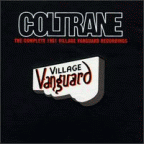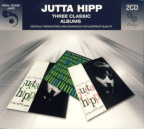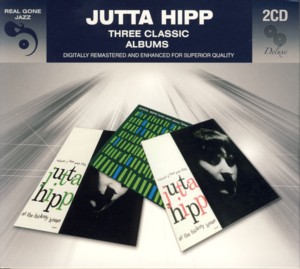Record Reviews
2 Reviews Found. Use search to find more reviews or follow the links in the review text.
  | JOHN COLTRANE ~ THE COMPLETE 1961 VILLAGE VANGUARD RECORDINGS
IMPULSE! 232 (Barcode: 011105023221) ~ USA ~ Jazz
Recorded: 1961 Released: 1997
When this music was recorded in November of 1961 I was only 10 years old and yet it changed my life forever. Living in (Socialist) Poland, my access to contemporary (at the time) jazz originating in the US was pretty limited and the only beacon of light was the daily Willis ConoverFind albums by this artist’s radio jazz program on Voice Of America, beamed from across the Iron Curtain. Millions of Eastern European listeners would risk freedom (listening to VOA was a criminal act then) to gain freedom, myself included. These broadcasts changed the life of countless people and particularly in Poland would eventually be a dominant factor in the process of forming a burgeoning and extremely fruitful local jazz scene. Many hours of my early childhood were spent with myself standing on a conductor’s podium (e sledge), in front of an imaginary orchestra playing inside the enormous radio (a pre WW II antique). Since classical music was less censored and sponsored by the Establishment, it was there for us to enjoy most of it of very high quality. I remember listening for hours at end to the annual Chopin competition, which was Poland’s most prestigious music event, getting to know his music inside out before I even knew anything about him. My Mother encouraged my “conducting” aspirations warmly, supplementing them with occasional background information. But the discovery of jazz and its strange convoluting patterns and unfamiliar rhythms was a revelation. I just couldn’t get enough of it and every new artist or piece of music was an instant bliss. By the time I was about to hear John ColtraneFind albums by this artist for the first time I was already familiar with the music of Duke EllingtonFind albums by this artist, Count BasieFind albums by this artist, Charlie ParkerFind albums by this artist and Dizzie GillespieFind albums by this artist (thanks to Mr. Conover). Conover, in contrast to many of his peers (who were stuck in be-bop or some earlier jazz sub-genre for the rest of their lives), was remarkably open-minded and understood the genius of Coltrane and his visionary contribution to the development of the Jazz Art form. He therefore featured every new Coltrane album as soon as it was released. So here I was, 10 years old, some time in early 1962, listening to the Village Vanguard sessions – an experience equivalent to a 10,000 Volts electricity shock. My life would definitely be never the same again. I hope these personal reminiscences don’t put you off too much, but I just couldn’t resist the temptation. Taking the time-travel express to now here are my comments about this music from a “45 years later” point of view. In 1961 Coltrane left AtlanticFind albums on this label (his second label, PrestigeFind albums on this label being the first) and signed a contract with Impulse!Find albums on this label, the new and ambitious jazz label run by producer Bob ThieleFind albums by this artist, where he would stay for the rest of his life. Coltrane was already following a path (mostly subconsciously) which would lead him to the edge of the known jazz explorations and beyond. His monumental Atlantic albums like Giant Steps and My Favorite Things were just a glimpse of things to come. Coltrane felt that Thiele would allow him to speed up the process of reaching the quest of musical enlightenment by allowing him total artistic freedom and supporting him all the way and he was of course right. The extensive volume of music recorded for Impulse! in the span of almost 7 years right up to his death would become the most important musical legacy of the 20th Century, so innovative and groundbreaking that it is still a mystery to many contemporary listeners and musicologists today. Coltrane’s first recording for Impulse! (in the spring of 1961) would be the Africa / Brass sessions, an ambitious project involving a large ensemble of the most gifted players on the scene (Freddie HubbardFind albums by this artist, Booker LittleFind albums by this artist, Eric DolphyFind albums by this artist and many others) – see The Complete Africa / Brass SessionsFind albums with this title album, another essential Coltrane release. These sessions introduce several new elements in Coltrane’s music, like Far-Eastern motifs, African rhythms and other ethnic influences. In November of 1961 Thiele decided to record Coltrane live, using the 4 nights booking at the NY club The Village Vanguard (where many jazz albums were recorded live) for this purpose. The booking was for a John Coltrane Quintet and it was only natural that the Quintet would include Eric Dolphy, whom Coltrane knew, respected and played with earlier. The legendary Quartet (with McCoy TynerFind albums by this artist, Jimmy GarrisonFind albums by this artist and Elvin JonesFind albums by this artist) was not entirely crystallized at the time, so Coltrane and Thiele decided to expand the line-up (on some takes) to include an oud player (Ahmed Abdul-MalikFind albums by this artist) and alternative bassist (Reggie WorkmanFind albums by this artist) and drummer (Roy HaynesFind albums by this artist). Since this music was recorded for a future release Thiele (as any produce would do) recorded several takes of each tune, some with an alternating line-up. This 4CDs Box Set includes all the music that was recorded during these four days (mind you not all the music that was played, as some of it was not recorded hence the “complete” being not entirely true) in the exact order it was recorded. This music was to be released later on two albums (Live At The Village Vanguard and The Other Village Vanguard Tapes) as well as parts of other albums (Impressions) and collections. Collected here together for the first time, this is a monumental piece of jazz history and an unforgettable musical experience. Coltrane’s circular breathing technique and his “wall of sound” approach are clearly evident here for the first time in their full glory. The comparison of the different versions of the same tunes are both fundamental and clairvoyant examples of the “one time experience” that every jazz performance essentially is. The power, the vision, the super-human strength of will of the Master and Prophet (please excuse the almost religious references) that Coltrane was, are here for us, his disciples, to discover, study, revere and bequest to future generations. This Box Set is something one has in one’s record collection for life. It is not only timeless, but also constantly evolving in parallel to one’s private (musical) evolution. Listening to it time after time (especially after a long period of abstention) will be revealing and constantly surprising. It is a superb example of great Art, which keeps alive for eternity, adopting itself to the changing cultural surroundings, and therefore being truly eternal. I can’t imagine anybody, who calls himself a music lover, not owning this music, as naive as this might sound, since I believe there is something in it for everybody. Beyond essential!
| | Updated: 26/01/2019Posted: | CD 4 Box Set Oversampling Remastered Bonus Tracks Essential Recommend To A Friend |
  | JUTTA HIPP ~ THREE CLASSIC ALBUMS
REAL GONE JAZZ 498 (Barcode: 5036408174420) ~ GERMANY ~ Jazz
Recorded: 1956 Released: 2015
This is a reissue of the three albums by German pianist Jutta HippFind albums by this artist, which were originally released on the Blue NoteFind albums on this label label in the mid 1950s. Hipp grew up in Nazi Germany and started to listen and pay Jazz secretly, as it was fiercely banned by the regime. After the WWII ended she was very active on the German scene, playing with the best German Jazz musicians, who were just starting their careers, like brothers: Emil MangelsdorffFind albums by this artist and Albert MangelsdorffFind albums by this artist, Austrian Hans KollerFind albums by this artist, Hungarian Attila ZollerFind albums by this artist (both resident in Germany) and others. Hipp moved to NY in 1955, with the help of the legendary Jazz critic Leonard FeatherFind albums by this artist, and recorded the three albums included here, after which she left music entirely, for reasons unclear.
The first two albums: "Live At The Hickory House Volume 1Find albums with this title" and "Live At The Hickory House Volume 2Find albums with this title" both originate from a live recording at the Hickory House club in NY. Hipp is accompanied by British bassist Peter IndFind albums by this artist and American drummer Ed ThigpenFind albums by this artist. Together they perform ten standards on each of these albums.
The third album "Jutta Hipp With Zoot SimsFind albums with this title" is a studio recording of a quintet which places her along American Jazz players: trumpeter Jerry LloydFind albums by this artist, saxophonist Zoot SimsFind albums by this artist, bassist Ahmed Abdul-MalikFind albums by this artist and drummer Ed Thigpen. The quintet performs six compositions, four of which are standards and one each is by Lloyd and Sims.
The astounding thing about this music is the fact that although modern European Jazz was not yet born, Hipp plays these commonly known standards with a twist, which puts her already at that time apart from the American pianists. She is way more original, inventive and elegant than the pianists who in many cases wrote these standards. Her European piano mannerisms, for which she was severely criticized by American Jazz players, an experience which probably was the reason why she gave up music, were already very distinctive and pointed out towards the rift that was about to happen between American and European Jazz just a few years later.
Anybody listening to these albums must realize that the criminally limited recorded legacy Hipp left us with is just a tip of an iceberg of an enormous talent which alas we´ll never witness. European Jazz lovers and connoisseurs of the twisted path European Jazz followed to differentiate itself from the American tradition will find this music absolutely indispensable. An absolute must for Jazz piano enthusiasts!
Side Note
The Real Gone JazzFind albums on this label label releases hundreds of album collections, which include usually between three to eight original albums in a two to four CDs sets. Most of these albums were recorded and released in the 1950s and early 1960s. These collections provide the track lists and lineups of the original albums, but no recording information, liner notes and any background information whatsoever. The label takes advantage of the copyright law in UK, which limited the length of the copyright protection of recorded works to 50 years, after which recorded works become public domain. In 2013 UK implemented a correction of the copyright law extending the protection of recorded works to 70 years (like the rest of Europe), but the correction does not apply retroactively, which means that recordings which entered the 50 years rule prior to January 1, 2013 (i.e. recorded before January 1, 1963) remain public domain.
There are two great advantages to these releases: they are really inexpensive and they bring back to life many albums not reissued previously on CD, which means it would cost a collector an arm and a leg to get a copy of them. Many of these albums are absolute gems and essential pieces of Jazz history.
The disadvantages are: the lack of proper information, original cover art, combining tracks of several original albums on one CD and the sound quality, which depends on where the label gets the source material. From my experience most of the releases have quite excellent sound quality but I have not listened to all of them and some people have complained about it.
| | Updated: 27/05/2018Posted: 18/05/2016 | CD 2 Digipak Remastered Recommend To A Friend |
|







